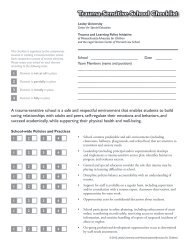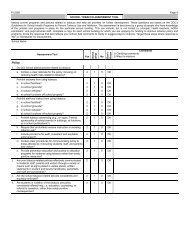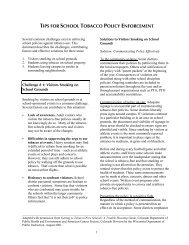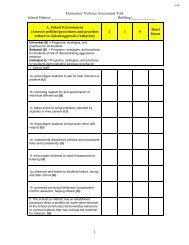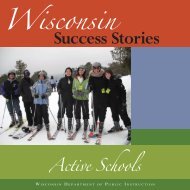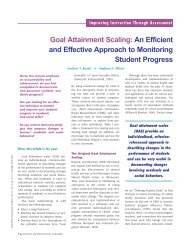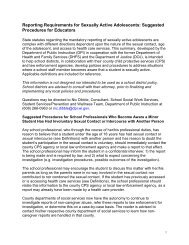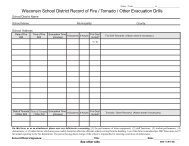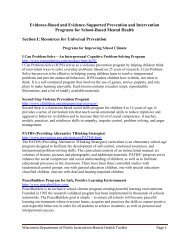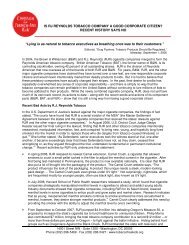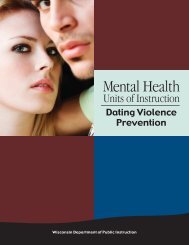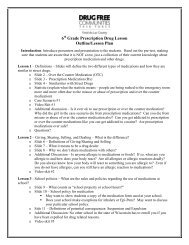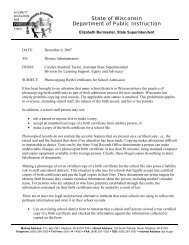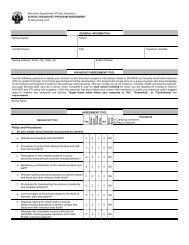lessons on communicable disease prevention - Student Services ...
lessons on communicable disease prevention - Student Services ...
lessons on communicable disease prevention - Student Services ...
Create successful ePaper yourself
Turn your PDF publications into a flip-book with our unique Google optimized e-Paper software.
LESSONS ON<br />
COMMUNICABLE<br />
DISEASE<br />
PREVENTION<br />
K-12<br />
<strong>Student</strong> <strong>Services</strong>/Preventi<strong>on</strong><br />
and Wellness Team<br />
WISCONSIN DEPARTMENT OF PUBLIC INSTRUCTION<br />
ELIZABETH BURMASTER, STATE SUPERINTENDENT
This publicati<strong>on</strong> is available from:<br />
<strong>Student</strong> <strong>Services</strong>/Preventi<strong>on</strong> and Wellness Team<br />
Wisc<strong>on</strong>sin Department of Public Instructi<strong>on</strong><br />
125 South Webster Street<br />
P.O. Box 7841<br />
Madis<strong>on</strong>, Wisc<strong>on</strong>sin 53707-7841<br />
(608) 266-8960<br />
(800) 441-4563<br />
This document is also available <strong>on</strong> the World Wide Web:<br />
dpi.wi.gov/sspw/___________________<br />
First Editi<strong>on</strong><br />
May 2009<br />
Wisc<strong>on</strong>sin Department of Public Instructi<strong>on</strong><br />
The Wisc<strong>on</strong>sin Department of Public Instructi<strong>on</strong> does not discriminate <strong>on</strong> the basis of sex, race, religi<strong>on</strong>,<br />
age, nati<strong>on</strong>al origin, ancestry, creed, pregnancy, marital or parental status, sexual orientati<strong>on</strong>, or physical,<br />
mental, emoti<strong>on</strong>al, or learning disability.<br />
Printed <strong>on</strong><br />
Recycled Paper
Acknowledgements<br />
The Wisc<strong>on</strong>sin Department of Public Instructi<strong>on</strong> (DPI) staff of the <strong>Student</strong> <strong>Services</strong> Preventi<strong>on</strong><br />
and Wellness Team resp<strong>on</strong>ded to the need for preventi<strong>on</strong> strategies to address the spread of<br />
<strong>communicable</strong> <strong>disease</strong>. One of the strategies was to develop a set of <str<strong>on</strong>g>less<strong>on</strong>s</str<strong>on</strong>g> for elementary,<br />
middle, and high school students that were engaging, age appropriate, and could c<strong>on</strong>nect to a<br />
number of c<strong>on</strong>tent areas such as Science, Art, Music and Social Studies and put them <strong>on</strong> the DPI<br />
Pandemic Flu web site for use by teachers. The <str<strong>on</strong>g>less<strong>on</strong>s</str<strong>on</strong>g> were adapted or developed by J<strong>on</strong> W.<br />
Hisgen, Health and Physical Activity C<strong>on</strong>sultant. Linda Carey served as the editor of the<br />
document.<br />
Reviewers<br />
Douglas White, Director<br />
<strong>Student</strong> <strong>Services</strong> Preventi<strong>on</strong> and Wellness Team, DPI<br />
Rachel Gallagher<br />
C<strong>on</strong>sultant, School Nursing <strong>Services</strong>, DPI<br />
Special thanks to the many teachers who helped develop the original performance based <str<strong>on</strong>g>less<strong>on</strong>s</str<strong>on</strong>g><br />
that were a part of DPI's School Health Performance Item development group.
Table of C<strong>on</strong>tents<br />
Elementary School<br />
Hand Washing C<strong>on</strong>cept Map .....................................................................................1<br />
Stop the Spread of Disease .........................................................................................7<br />
You are the Teacher ..................................................................................................11<br />
How Vaccines Work .................................................................................................15<br />
Middle School<br />
Inspector Bacterium ..................................................................................................21<br />
The Germs Go Marching In ......................................................................................27<br />
Archaeological Dig ...................................................................................................33<br />
Middle or High School<br />
The Great CDC Scavenger Hunt ..............................................................................41<br />
Who Gets the Drug..................................................................................................47<br />
Attack of the Super Bug ............................................................................................53<br />
iii
Elementary<br />
School
C<strong>on</strong>tent Area:<br />
Performance Task:<br />
Educati<strong>on</strong>al Level:<br />
Communicable Disease Preventi<strong>on</strong><br />
“Hand Washing C<strong>on</strong>cept Map”<br />
Elementary School<br />
<strong>Student</strong> Instructi<strong>on</strong>s<br />
After learning about how to wash our hands and the importance of washing hands properly,<br />
you show what you have learned by completing a hand washing c<strong>on</strong>cept map.<br />
Assessment Criteria<br />
Answers will be scored <strong>on</strong> the following:<br />
1. How well you complete the c<strong>on</strong>cept map with correct informati<strong>on</strong>.<br />
2. How well you understand why we should wash our hands.<br />
3. How well you understand when to wash our hands.<br />
4. How well you understand how to properly wash hands.<br />
5. How well you understand what can be d<strong>on</strong>e when we are unable to wash our hands<br />
properly.<br />
1
After learning all about washing our hands, let’s fill in this c<strong>on</strong>cept map!<br />
When should<br />
we wash our<br />
hands<br />
How should we<br />
wash our<br />
hands<br />
Washing our Hands<br />
Washing our Hands<br />
What can we<br />
do if we need to<br />
wash our hands<br />
and there is no<br />
sink or hot<br />
water<br />
Why is it<br />
important to<br />
wash our hands<br />
2
C<strong>on</strong>tent Area:<br />
Performance Task:<br />
Educati<strong>on</strong>al Level:<br />
Communicable Disease Preventi<strong>on</strong><br />
“Hand Washing C<strong>on</strong>cept Map”<br />
Elementary School<br />
Curriculum C<strong>on</strong>necti<strong>on</strong>s<br />
Language Arts, Health Educati<strong>on</strong><br />
Teacher Informati<strong>on</strong><br />
Overview<br />
<strong>Student</strong>s create the attached c<strong>on</strong>cept map <strong>on</strong> different aspects of hand washing.<br />
Requirements<br />
<strong>Student</strong>s receive a copy of the hand washing c<strong>on</strong>cept map to fill in resp<strong>on</strong>ses to questi<strong>on</strong>s.<br />
<strong>Student</strong>s show understanding of when, how, and what of washing hands as well as what<br />
precauti<strong>on</strong>s can be taken in a situati<strong>on</strong> where appropriate hand washing facilities are not<br />
available.<br />
Time<br />
This assessment can be completed in <strong>on</strong>e class period.<br />
Materials<br />
Hand washing c<strong>on</strong>cept map, pen, or pencil<br />
3
Instructi<strong>on</strong>s<br />
Provide instructi<strong>on</strong> <strong>on</strong> various aspects of hand washing, including instructi<strong>on</strong> <strong>on</strong> the spread<br />
of bacteria and possible use of hand sanitizers. A glow germ presentati<strong>on</strong> might be<br />
helpful.<br />
Assessment Criteria<br />
Answers will be scored <strong>on</strong> the following:<br />
<strong>Student</strong>s show how well they understand the when, how, and why of hand washing as well<br />
as what to do when appropriate hand washing facilities are not available.<br />
A<br />
B<br />
C<br />
D<br />
E<br />
F<br />
G<br />
Wisc<strong>on</strong>sin Health Educati<strong>on</strong> Standards<br />
Disease preventi<strong>on</strong> and health promoti<strong>on</strong><br />
Health behavior<br />
Goal setting and decisi<strong>on</strong>-making<br />
Accessing accurate informati<strong>on</strong><br />
Impact of culture and media<br />
Communicati<strong>on</strong> skills<br />
Advocacy<br />
4
Sample Resp<strong>on</strong>se<br />
Hand washing is the single most important preventi<strong>on</strong> step for reducing the spread of<br />
<strong>disease</strong>. Hands should always be washed up<strong>on</strong> exiting animal areas and before eating or<br />
drinking.<br />
HOW<br />
Wet hands with running water; place soap in palms; rub together to make a lather; scrub<br />
hands vigorously as you say the ABC s<strong>on</strong>g.<br />
Dry hands with a clean towel. Do not dry hands <strong>on</strong> clothing.<br />
WHEN<br />
After touching animals.<br />
Before eating.<br />
After using rest rooms.<br />
WHY<br />
It is the single most important preventi<strong>on</strong> step for reducing the spread of <strong>disease</strong>.<br />
WHAT<br />
Use hot water if possible. If <strong>on</strong>ly cold water is available, use a soap that works effectively<br />
in cold water. If there is no sink, running water that has some pressure and volume will<br />
work if there is soap available. Hand sanitizers can work if no other hand washing stati<strong>on</strong> is<br />
available.<br />
5
C<strong>on</strong>tent Area:<br />
Performance Event:<br />
Educati<strong>on</strong>al Level:<br />
Communicable Disease Preventi<strong>on</strong><br />
“Stop the Spread of Disease”<br />
Elementary School<br />
<strong>Student</strong> Instructi<strong>on</strong>s<br />
In this activity, you will make a Stop the Spread of Disease book. On each page of your<br />
booklet is listed a general healthy behavior that works to stop the spread of <strong>disease</strong>. Draw<br />
a picture of that healthy behavior and print informati<strong>on</strong> that explains your drawing so that<br />
students your age can understand your explanati<strong>on</strong>. When your booklet is finished, make a<br />
cover and write a title <strong>on</strong> it.<br />
Your booklet should include the following:<br />
1. A book cover with a title.<br />
2. A page for each healthy behavior. List the behavior, draw a picture of the<br />
behavior, and tell about your behavior.<br />
Assessment Criteria<br />
Answers will be scored <strong>on</strong> the following:<br />
1. How well you understand health informati<strong>on</strong> <strong>on</strong> healthy hygiene.<br />
2. How well you dem<strong>on</strong>strate an understanding of individual resp<strong>on</strong>sibility as it applies<br />
to healthy behaviors.<br />
7
C<strong>on</strong>tent Area:<br />
Performance Event:<br />
Educati<strong>on</strong>al Level:<br />
Communicable Disease Preventi<strong>on</strong><br />
“Stop the Spread of Disease”<br />
Elementary School<br />
Curriculum C<strong>on</strong>necti<strong>on</strong>s<br />
Art, Language Arts, Health Educati<strong>on</strong><br />
Teacher Informati<strong>on</strong><br />
Overview<br />
This activity promotes the practice of healthy behaviors.<br />
Requirements<br />
Children in the primary grades will make booklets to promote healthy behaviors. They<br />
should include the following:<br />
• Hand washing.<br />
• Proper coughing technique.<br />
• What to do if you begin coughing, have a headache, or start to sneeze.<br />
• When to tell parents, teachers, or school nurses about how you feel.<br />
• Other behaviors you think are important to stop the spread of <strong>disease</strong>.<br />
Each page of the booklet should list <strong>on</strong>e healthy behavior, illustrate the behavior, and<br />
include informati<strong>on</strong> about the behavior. <strong>Student</strong>s assemble their work into a booklet with<br />
cover pages of two sheets of c<strong>on</strong>structi<strong>on</strong> paper. They design a cover and give their<br />
booklet a title. If time permits, the students could read their booklets to other students.<br />
Teachers may want to include pages <strong>on</strong> how <strong>disease</strong>s spread. This is an individual<br />
assignment.<br />
Time<br />
This task will take two class periods to complete.<br />
Materials<br />
<strong>Student</strong>s will need paper labeled with behaviors, c<strong>on</strong>structi<strong>on</strong> paper, pencils, markers or<br />
cray<strong>on</strong>s, and a stapler.<br />
Instructi<strong>on</strong><br />
Explain how pers<strong>on</strong>al health choices and behaviors play an important role in <strong>disease</strong><br />
preventi<strong>on</strong>.<br />
9
Assessment Criteria<br />
Answers will be scored <strong>on</strong> the following:<br />
1. How well students understand health informati<strong>on</strong> to prevent the spread of <strong>disease</strong>.<br />
2. How well students dem<strong>on</strong>strate an understanding of the impact individual resp<strong>on</strong>sibility<br />
has <strong>on</strong> healthy behaviors.<br />
A<br />
B<br />
C<br />
D<br />
E<br />
F<br />
G<br />
Wisc<strong>on</strong>sin Health Educati<strong>on</strong> Standards<br />
Disease preventi<strong>on</strong> and health promoti<strong>on</strong><br />
Health behavior<br />
Goal setting and decisi<strong>on</strong>-making<br />
Accessing accurate informati<strong>on</strong><br />
Impact of culture and media<br />
Communicati<strong>on</strong> skills<br />
Advocacy<br />
Sample Resp<strong>on</strong>se<br />
Cover and Title<br />
*The Stop the Spread Train<br />
Drawing of a train with five cars, each <strong>on</strong>e representing <strong>on</strong>e health behavior. The behavior<br />
is listed <strong>on</strong> the side of each car.<br />
Healthy Habit One:<br />
Washing hands before eating will prevent the children from getting germs in their mouth<br />
or <strong>on</strong> their food from dirty hands.<br />
Healthy Habit Two:<br />
*When you cough, do it right.<br />
Cough into your clothes <strong>on</strong> your arm.<br />
Healthy Habit Three:<br />
*Tell you teacher, nurse, or parent.<br />
If you have a fever or you’re sneezing or coughing, tell some<strong>on</strong>e who can help.<br />
Health Habit Four:<br />
*Use a hand sanitizer.<br />
When there is no place for hand washing use a hand sanitizer.<br />
10
C<strong>on</strong>tent Area:<br />
Performance Event:<br />
Educati<strong>on</strong>al Level:<br />
Communicable Disease Preventi<strong>on</strong><br />
“You are the Teacher”<br />
Elementary School<br />
<strong>Student</strong> Instructi<strong>on</strong>s<br />
In this activity, you will choose <strong>on</strong>e of the following safe behaviors and create a poster and<br />
what you would say to some<strong>on</strong>e else about why this behavior is important. Draw a picture<br />
of that healthy behavior, include any preventi<strong>on</strong> materials to be used, and print<br />
informati<strong>on</strong> that explains your drawing so that students your age can understand your<br />
explanati<strong>on</strong>. When your poster is finished you are going to share it with the rest of the<br />
class.<br />
Choose <strong>on</strong>e of the following<br />
1. Communicable <strong>disease</strong> is spread by coughing or sneezing.<br />
2. Cover your nose and mouth with a tissue when you cough or sneeze. Throw the<br />
tissue in the trash after you use it.<br />
3. Wash your hands with soap and water, especially after you cough or sneeze.<br />
4. Alcohol-based hand cleaners called sanitizers are also effective.<br />
5. Clean your desk with disinfecting wipes often.<br />
6. Avoid touching your eyes, nose, or mouth.<br />
7. If you think you are becoming sick or you are speaking to some<strong>on</strong>e who sneezes or<br />
coughs, keep a social distance away from that pers<strong>on</strong>.<br />
8. Stay home if you get sick.<br />
Assessment Criteria<br />
Answers will be scored <strong>on</strong> the following:<br />
1. How well you understand health informati<strong>on</strong> <strong>on</strong> healthy hygiene and preventi<strong>on</strong> of the<br />
spread of <strong>disease</strong>.<br />
2. How well you dem<strong>on</strong>strate an understanding of healthy behaviors as it applies to the<br />
preventi<strong>on</strong> of the spread of <strong>disease</strong>.<br />
11
C<strong>on</strong>tent Area:<br />
Performance Event:<br />
Educati<strong>on</strong>al Level:<br />
Communicable Disease Preventi<strong>on</strong><br />
“You are the Teacher”<br />
Elementary School<br />
Curriculum C<strong>on</strong>necti<strong>on</strong>s<br />
Art, Language Arts, Health Educati<strong>on</strong><br />
Teacher Informati<strong>on</strong><br />
Overview<br />
This activity promotes the practice of healthy behaviors.<br />
Requirements<br />
In this activity, the student will choose <strong>on</strong>e of the following safe behaviors and create a<br />
poster and what they would say to some<strong>on</strong>e else about why this behavior is important.<br />
Draw a picture of that healthy behavior, include any preventi<strong>on</strong> materials to be used, and<br />
print informati<strong>on</strong> that explains the drawing so that other students their age can<br />
understand the explanati<strong>on</strong>. When the poster is finished each student is going to share it<br />
with the rest of the class.<br />
Choose <strong>on</strong>e of the following<br />
1. Communicable <strong>disease</strong> is spread by coughing or sneezing.<br />
2. Cover your nose and mouth with a tissue when you cough or sneeze. Throw the<br />
tissue in the trash after you use it.<br />
3. Wash your hands with soap and water, especially after you cough or sneeze.<br />
4. Alcohol-based hand cleaners called sanitizers are also effective.<br />
5. Clean your desk with disinfecting wipes often.<br />
6. Avoid touching your eyes, nose, or mouth.<br />
7. If you think you are becoming sick or you are speaking to some<strong>on</strong>e who sneezes or<br />
coughs, keep a social distance away from that pers<strong>on</strong>.<br />
8. Stay home if you get sick.<br />
Time<br />
This task will take two class periods to complete and present to the rest of the class.<br />
Materials<br />
<strong>Student</strong>s will need paper labeled with behaviors, c<strong>on</strong>structi<strong>on</strong> paper, pencils, markers or<br />
cray<strong>on</strong>s, and a stapler. Pictures or real examples of such things as tissue paper, soap,<br />
disinfecting wipes, alcohol-based hand cleaners will help bring realism to the poster.<br />
13
Instructi<strong>on</strong><br />
Explain how pers<strong>on</strong>al preventi<strong>on</strong> choices and behaviors play an important role in <strong>disease</strong><br />
preventi<strong>on</strong>.<br />
Assessment Criteria<br />
Answers will be scored <strong>on</strong> the following:<br />
1. How well the student understands health informati<strong>on</strong> <strong>on</strong> healthy hygiene and<br />
preventi<strong>on</strong> of the spread of <strong>disease</strong>.<br />
2. How well the student dem<strong>on</strong>strates an understanding of healthy behaviors as it<br />
applies to the preventi<strong>on</strong> of the spread of <strong>disease</strong>.<br />
A<br />
B<br />
C<br />
D<br />
E<br />
F<br />
G<br />
Wisc<strong>on</strong>sin Health Educati<strong>on</strong> Standards<br />
Disease preventi<strong>on</strong> and health promoti<strong>on</strong><br />
Health behavior<br />
Goal setting and decisi<strong>on</strong>-making<br />
Accessing accurate informati<strong>on</strong><br />
Impact of culture and media<br />
Communicati<strong>on</strong> skills<br />
Advocacy<br />
Sample Resp<strong>on</strong>se<br />
I keep my world clean of viruses because I use Disinfecting Wipes.<br />
Poster of a student cleaning their desk with wipes.<br />
I would use this product because it cleans almost all germs and kills the flu virus.<br />
14
C<strong>on</strong>tent Area:<br />
Performance Event:<br />
Educati<strong>on</strong>al Level:<br />
Communicable Disease Preventi<strong>on</strong><br />
“How Vaccines Work”<br />
Elementary School<br />
<strong>Student</strong> Instructi<strong>on</strong>s<br />
You are asked to show how germs make us sick, how our bodies fight infecti<strong>on</strong>, and how<br />
vaccines work. In small groups of three, invent a sickness and present the following:<br />
1. Draw what a germ looks like under the microscope.<br />
2. Draw how the germ is transmitted or spread.<br />
3. Draw the symptoms of the infecti<strong>on</strong>.<br />
4. Explain how the <strong>disease</strong> can be prevented by the use of a vaccine. Include pictures<br />
of the antigen (germ) and the antibody (fighter cell).<br />
5. Use the lock and key c<strong>on</strong>cept to form this explanati<strong>on</strong>—the fighter cell locks up the<br />
germ so it can no l<strong>on</strong>ger harm the body.<br />
6. Describe the model to the class.<br />
Assessment Criteria<br />
Answers will be scored <strong>on</strong> the following:<br />
1. How well you show that you understand the health informati<strong>on</strong> about how vaccines<br />
work.<br />
2. How well you explain the benefits of the following:<br />
• Being resp<strong>on</strong>sible for your own health.<br />
• Avoiding a threatening situati<strong>on</strong>.<br />
15
C<strong>on</strong>tent Area:<br />
Performance Event:<br />
Educati<strong>on</strong>al Level:<br />
Communicable Disease Preventi<strong>on</strong><br />
“How Vaccines Work”<br />
Elementary School<br />
Curriculum C<strong>on</strong>necti<strong>on</strong>s<br />
Art, Science, Health Educati<strong>on</strong><br />
Teacher Informati<strong>on</strong><br />
Overview<br />
This activity will help you see how well students understand the role of vaccines in<br />
preventing <strong>disease</strong>. Although the children know they go see the doctor to get shots, it is<br />
necessary for the students to learn what vaccines are and how they work.<br />
Requirements<br />
<strong>Student</strong>s will need to have previous instructi<strong>on</strong> <strong>on</strong> how germs can make us sick, how the<br />
immune system works, and how vaccines prevent certain <strong>disease</strong>s.<br />
Time<br />
This task will take two to three class periods to complete and present to the rest of the<br />
class.<br />
Materials<br />
Markers or cray<strong>on</strong>s, a pen, or a pencil.<br />
Instructi<strong>on</strong><br />
Prior to the less<strong>on</strong> develop a lock and key model of the class activity by using a real germ<br />
and sickness like chicken pox. You may wish to invite the school nurse or another health<br />
care professi<strong>on</strong>al to provide further discussi<strong>on</strong>s <strong>on</strong> preventi<strong>on</strong> and c<strong>on</strong>trol of <strong>disease</strong>.<br />
Assessment Criteria<br />
Answers will be scored <strong>on</strong> the following:<br />
1. How well the student shows an understanding of the health informati<strong>on</strong> about<br />
how vaccines work.<br />
2. How well the student explains the benefits of the following:<br />
• Being resp<strong>on</strong>sible for your own health.<br />
• Avoiding a threatening situati<strong>on</strong>.<br />
17
A<br />
B<br />
C<br />
D<br />
E<br />
F<br />
G<br />
Wisc<strong>on</strong>sin Health Educati<strong>on</strong> Standards<br />
Disease preventi<strong>on</strong> and health promoti<strong>on</strong><br />
Health behavior<br />
Goal setting and decisi<strong>on</strong>-making<br />
Accessing accurate informati<strong>on</strong><br />
Impact of culture and media<br />
Communicati<strong>on</strong> skills<br />
Advocacy<br />
Sample Resp<strong>on</strong>se<br />
Germs Make Us Sick<br />
1. Draw and label your germ<br />
• Flu Germ<br />
2. How is the germ transmitted or spread<br />
• Coughing and sneezing.<br />
3. Draw symptoms of the infecti<strong>on</strong><br />
• Fever<br />
• Sore throat<br />
• Cough<br />
4. Explain how the <strong>disease</strong> can be prevented by the use of a vaccine.<br />
• A flu shot with vaccine can block most flu germs from making some<strong>on</strong>e sick.<br />
5. Draw a picture of an antigen (germ) and the antibody (fighter cell) using the lock and key<br />
c<strong>on</strong>cept.<br />
6. Describe and share your example with the class.<br />
18
Middle School<br />
19
C<strong>on</strong>tent Area:<br />
Performance Task:<br />
Educati<strong>on</strong>al Level:<br />
Communicable Disease Preventi<strong>on</strong><br />
“Inspector Bacterium”<br />
Middle School<br />
<strong>Student</strong> Instructi<strong>on</strong>s<br />
Follow these steps to complete this assignment:<br />
1. Each team of two will create a hypothesis as to what surface in the school is most<br />
likely to be c<strong>on</strong>taminated with germs and what part of the body is also the most<br />
c<strong>on</strong>taminated.<br />
2. Each team will present their hypotheses written <strong>on</strong> paper to the rest of the class.<br />
3. Each team will be given <strong>on</strong>e agar plate to test <strong>on</strong>e of their hypotheses.<br />
4. Each team will get a sample using a cott<strong>on</strong> swab of a particular area or a body part.<br />
Here are the areas to choose from:<br />
• Bubbler<br />
• Weight room<br />
• Gym floor<br />
• Wrestling mat<br />
• Classroom desk<br />
• Table in the class<br />
• Table in the lunchroom<br />
• Door knob entering the room<br />
• Dry eraser board<br />
Here are the body parts to choose from<br />
• Mouth<br />
• Nose<br />
• Back of hands by the nails<br />
• Toes<br />
• Arm pit<br />
After an overnight incubati<strong>on</strong> determine as a class which petri dish had the greatest<br />
bacteria count.<br />
The final part of this assignment is to present some ways of eliminating or lessening this<br />
c<strong>on</strong>taminati<strong>on</strong> from your hypothesis paper.<br />
21
Assessment Criteria<br />
The student activities will be scored <strong>on</strong> the following:<br />
1. How effectively you evaluate informati<strong>on</strong> about c<strong>on</strong>taminati<strong>on</strong>.<br />
2. How correctly you understand sites that can easily be c<strong>on</strong>taminated<br />
3. How well you identify safe behaviors that will prevent you from being c<strong>on</strong>taminated.<br />
22
C<strong>on</strong>tent Area:<br />
Performance Task:<br />
Educati<strong>on</strong>al Level:<br />
Communicable Disease Preventi<strong>on</strong><br />
“Inspector Bacterium”<br />
Middle School<br />
Curriculum C<strong>on</strong>necti<strong>on</strong>s<br />
Science, Health Educati<strong>on</strong>, Language Arts,<br />
Teacher Informati<strong>on</strong><br />
Overview<br />
This activity has to do with determining areas of the school and the body that are likely to<br />
become c<strong>on</strong>taminated. <strong>Student</strong>s will hypothesize which areas of the school and the body<br />
are likely to be c<strong>on</strong>taminated, test their hypothesis, and develop strategies to prevent<br />
them from becoming c<strong>on</strong>taminated from this source.<br />
Requirements<br />
Follow these steps to complete this assignment:<br />
1. Each team of two will present a hypothesis as to what surface in the school is most<br />
likely to be c<strong>on</strong>taminated with germs and what part of the body is also the most<br />
c<strong>on</strong>taminated.<br />
2. Each team will present their hypothesis written <strong>on</strong> paper to the rest of the class.<br />
3. Each team will be given <strong>on</strong>e agar plate to test <strong>on</strong>e of their hypotheses.<br />
4. Each team will get a sample using a cott<strong>on</strong> swab of a particular area or a body part.<br />
Here are the areas to choose from:<br />
• Computer keyboard<br />
• Weight room<br />
• Gym floor<br />
• Wrestling mat<br />
• Classroom desk<br />
• Table in the class<br />
• Table in the lunchroom<br />
• Door knob entering the room<br />
• Dry eraser board<br />
Here are the body parts to choose from<br />
• Mouth<br />
• Nose<br />
23
• Back of hands by the nails<br />
• Toes<br />
• Arm pit<br />
After an overnight incubati<strong>on</strong> determine, as a class, which petri dish had the greatest<br />
bacteria count.<br />
The final part of this assignment is to present some ways of eliminating or lessening this<br />
c<strong>on</strong>taminati<strong>on</strong> from your hypothesis paper.<br />
Time<br />
This task will c<strong>on</strong>tinue over two class periods.<br />
Materials<br />
Worksheet to write their hypothesis, their ways of preventing becoming c<strong>on</strong>taminated, a<br />
petri dish with a cott<strong>on</strong> swab.<br />
Purchasing agar<br />
http://sciencebuddies.org This site is excellent because it discusses what agar is and how<br />
it is used.<br />
The Best Agar for <strong>Student</strong> Projects<br />
For students growing bacteria at home without the supervisi<strong>on</strong> of a teacher (for example,<br />
investigating bacteria growth at various places around the house), it's important to use an<br />
agar formulati<strong>on</strong> that does not preferentially grow <strong>on</strong>e kind of bacteria over another. The<br />
worst case would be <strong>on</strong>e that preferentially grew pathogenic bacteria. Therefore, we<br />
recommend a plain nutrient agar, of which LB agar is a subtype.<br />
There are many different suppliers for LB agar. Because some suppliers will often <strong>on</strong>ly sell<br />
to students directly, you may have to have your teacher order for you. If you are doing a<br />
project that involves inoculati<strong>on</strong> and plate streaking, we highly recommend c<strong>on</strong>ducting the<br />
experiment at a school lab under teacher supervisi<strong>on</strong>.<br />
24
Some suggested suppliers are:<br />
Supplier<br />
Catalog<br />
Number C<strong>on</strong>tact Info Cost<br />
Number of<br />
plates<br />
Science Kit &<br />
Boreal<br />
Laboratories<br />
WW6564600 www.sciencekit.com<br />
800-828-7777<br />
$10.50 for 10 prepoured<br />
plates of<br />
nutrient agar<br />
10<br />
Carolina<br />
Biological<br />
Supplies<br />
82-1045 www.carolina.com<br />
800-334-5551<br />
$23.25 per kit (enough<br />
for 20 plates)<br />
20<br />
Bio-Rad<br />
Laboratories<br />
166-0600EDU www.bio-rad.com<br />
800-424-6723<br />
$8.00 for 6.9g of LB<br />
Nutrient Agar Powder<br />
40<br />
Sigma L7025 www.sigma-aldrich.com<br />
800-325-5832<br />
$63.60 for 100 tablets<br />
(1.68g per tablet)<br />
500<br />
Instructi<strong>on</strong>s<br />
Instructi<strong>on</strong> should cover ways germs are transmitted and how they end up <strong>on</strong> materials in a<br />
public building as well as the human body. A discussi<strong>on</strong> of the educated guess called the<br />
hypothesis should be covered and an overview of strategies to prevent students from<br />
becoming c<strong>on</strong>taminated should also be discussed.<br />
Assessment Criteria<br />
Answers will be scored <strong>on</strong> the following:<br />
1. How effectively the student evaluates informati<strong>on</strong> about c<strong>on</strong>taminati<strong>on</strong>.<br />
2. How correctly the student understands sites that can easily be c<strong>on</strong>taminated.<br />
3. How well the student identifies safe behaviors that will prevent them from being<br />
c<strong>on</strong>taminated.<br />
A<br />
B<br />
C<br />
D<br />
E<br />
F<br />
G<br />
Wisc<strong>on</strong>sin Health Educati<strong>on</strong> Standards<br />
Disease preventi<strong>on</strong> and health promoti<strong>on</strong><br />
Health behavior<br />
Goal setting and decisi<strong>on</strong>-making<br />
Accessing accurate informati<strong>on</strong><br />
Impact of culture and media<br />
Communicati<strong>on</strong> skills<br />
Advocacy<br />
25
Sample Resp<strong>on</strong>se<br />
My hypothesis is that the wrestling mat has the highest bacterial count because a lot of<br />
bodies are always <strong>on</strong> it. As it turns out I was wr<strong>on</strong>g because it is cleaned every day by the<br />
custodial staff.<br />
26
C<strong>on</strong>tent Area:<br />
Performance Task:<br />
Educati<strong>on</strong>al Level:<br />
Communicable Disease Preventi<strong>on</strong><br />
“The Germs Go Marching In”<br />
Middle School<br />
<strong>Student</strong> Instructi<strong>on</strong>s<br />
Follow these steps to complete this assignment:<br />
1. Gather informati<strong>on</strong> <strong>on</strong> preventing the spread of germs from pers<strong>on</strong> to pers<strong>on</strong>.<br />
2. Divide into small groups.<br />
3. In small groups, develop s<strong>on</strong>g lyrics to the tune of “The Germs Go Marching In” or<br />
“When Johnny Comes Marching Home Again.”<br />
4. Small groups will perform their s<strong>on</strong>g lyrics to the class.<br />
Assessment Criteria<br />
Answers will be assessed <strong>on</strong> the following:<br />
1. How well you dem<strong>on</strong>strate an understanding of the effective hygiene habits.<br />
2. How well you participate in the development and presentati<strong>on</strong> of the s<strong>on</strong>g.<br />
27
C<strong>on</strong>tent Area:<br />
Performance Task:<br />
Educati<strong>on</strong>al Level:<br />
Communicable Disease Preventi<strong>on</strong><br />
“The Germs Go Marching In”<br />
Middle School<br />
Teacher Informati<strong>on</strong><br />
Curriculum C<strong>on</strong>necti<strong>on</strong>s<br />
Health Educati<strong>on</strong>, Language Arts, Music Educati<strong>on</strong><br />
Overview<br />
This activity requires students to identify possible hygiene risks related to a<br />
<strong>communicable</strong> <strong>disease</strong>. <strong>Student</strong>s will receive hygiene informati<strong>on</strong> and apply it to the<br />
development of lyrics sung to the tune of “The Germs Go Marching In,” or “When Johnny<br />
Comes Marching Home Again.”<br />
Requirements<br />
The students are asked to do the following:<br />
1. Gather informati<strong>on</strong> <strong>on</strong> healthy hygiene behaviors and risks as they relate to positive<br />
hygiene behaviors, such as a day at school.<br />
2. Develop s<strong>on</strong>g lyrics to the tune of “The Germs Go Marching In” or “When Johnny<br />
Comes Marching Home Again.”<br />
3. Perform their s<strong>on</strong>g lyrics to the class.<br />
Time<br />
One to two class periods.<br />
29
Materials<br />
Text material and resources outlining safe food handling habits, lyrics and recording of<br />
“When Johnny Comes Marching Home Again,” or “The Saints Go Marching In,” paper and<br />
pencil<br />
Instructi<strong>on</strong>s<br />
1. Provide informati<strong>on</strong> <strong>on</strong> safe hygiene habits and risks as they relate public places like<br />
school.<br />
Suggested Extensi<strong>on</strong>: <strong>Student</strong>s might develop a peer educati<strong>on</strong> project to<br />
teach their hygiene s<strong>on</strong>gs to elementary students.<br />
Assessment Criteria<br />
Answers will be scored <strong>on</strong> the following:<br />
1. How well you dem<strong>on</strong>strate an understanding of the effective hygiene habits.<br />
2. How well you participate in the development and presentati<strong>on</strong> of the s<strong>on</strong>g.<br />
Wisc<strong>on</strong>sin Health Educati<strong>on</strong> Standards<br />
A Disease preventi<strong>on</strong> and health promoti<strong>on</strong><br />
B Health behavior<br />
C Goal setting and decisi<strong>on</strong>-making<br />
D Accessing accurate informati<strong>on</strong><br />
E Impact of culture and media<br />
F Communicati<strong>on</strong> skills<br />
G Advocacy<br />
Sample Resp<strong>on</strong>se<br />
The Germs Go Marching In (Tune of “When Johnny Comes Marching Home Again”)<br />
The germs go marching <strong>on</strong>e by <strong>on</strong>e, hurrah, hurrah;<br />
The germs go marching <strong>on</strong>e by <strong>on</strong>e, hurrah, hurrah.<br />
The students wet hands and soap them good to stop the germs from marching in.<br />
The germs go marching two by two, hurrah, hurrah;<br />
The germs go marching two by two, hurrah, hurrah.<br />
(repeat chorus)<br />
The students who are coughing and sneezing, its gross, its gross.<br />
The students who are coughing and sneezing, its gross, its gross.<br />
30
They stay at home and do their wheezing, hurrah, hurrah.<br />
But the teacher stops to rub his tummy, and he goes down to the john with runnys.<br />
To the john, to the john, boom, boom, boom.<br />
Uncle Harry covers his mouth hurrah, hurrah.<br />
Uncle Harry wants the flu to go south, hurrah, hurrah<br />
He always coughs into a Kleenex. And stays far away from those who d<strong>on</strong>’t<br />
To the waste basket, to the waste basket, boom, boom, boom.<br />
Could this happen to you To you To you To you<br />
Could this happen to you To you To you<br />
Practice all your safety rules.<br />
If you d<strong>on</strong>’t, you are the fools, boom, boom, boom.<br />
31
C<strong>on</strong>tent Area:<br />
Performance Event:<br />
Educati<strong>on</strong>al Level:<br />
Communicable Disease Preventi<strong>on</strong><br />
“Archaeological Dig”<br />
Middle School<br />
<strong>Student</strong> Instructi<strong>on</strong>s<br />
In this activity you will analyze the artifacts pulled from an archaeological dig box to<br />
determine whether the items found had a negative or positive impact <strong>on</strong> the spread of<br />
<strong>disease</strong>. Indicate which items or item had the greatest positive or negative impact <strong>on</strong> the<br />
civilizati<strong>on</strong>. Compare the items found with items available to us today. Are we using more<br />
or less of the artifact How does this affect our health Record your answers <strong>on</strong> the<br />
attached worksheet.<br />
Assessment Criteria<br />
Answers will be scored <strong>on</strong> the following:<br />
How well you show that you understand health c<strong>on</strong>cepts related to <strong>communicable</strong> <strong>disease</strong><br />
preventi<strong>on</strong>.<br />
33
Archaeological Dig Worksheet<br />
You are the member of an archaeological team who has removed some artifacts during an<br />
excavati<strong>on</strong> of a Wisc<strong>on</strong>sin site.<br />
1. Your task is to determine whether the item helps prevent or spread <strong>disease</strong>s or has no<br />
impact and why.<br />
Artifacts<br />
Disease<br />
Spreading<br />
Disease<br />
Preventing<br />
No<br />
Impact<br />
Why<br />
1. Soap<br />
2. Alcohol hand sanitizers<br />
3. Toilet seat<br />
4. Castor Oil<br />
5. Pers<strong>on</strong> cleaning their desk top<br />
6. Picture of polluti<strong>on</strong><br />
7. Iodine salts<br />
8. Informati<strong>on</strong> <strong>on</strong> covering your<br />
nose and mouth when sneezing<br />
9. Ads for anti-viral drugs<br />
10. Picture of pers<strong>on</strong> coughing in<br />
class<br />
2. Determine which item had the greatest negative impact <strong>on</strong> the health and why.<br />
3. For those items still available to us today: Are we using more or less of these artifacts<br />
today Why<br />
4. How does use of these items today affect our pers<strong>on</strong>al health<br />
34
C<strong>on</strong>tent Area:<br />
Performance Event:<br />
Educati<strong>on</strong>al Level:<br />
Communicable Disease Preventi<strong>on</strong><br />
“Archaeological Dig”<br />
Middle School<br />
Teacher Informati<strong>on</strong><br />
Curriculum C<strong>on</strong>necti<strong>on</strong>s<br />
Social Studies, Health Educati<strong>on</strong>, Language Arts<br />
Overview<br />
The students will have discussed risk behaviors in their lives and which <strong>on</strong>es have been<br />
proven by research to have the greatest influence <strong>on</strong> the health of the individual and the<br />
society in general. This event will explore the impact of health decisi<strong>on</strong>s <strong>on</strong> an earlier time<br />
in history and what behaviors might have been more risky.<br />
Time<br />
The assignment can be completed in <strong>on</strong>e class period.<br />
Materials<br />
Pens or pencils with the worksheet<br />
Instructi<strong>on</strong><br />
The students will have discussed some of the major behaviors that impact the spread of<br />
<strong>communicable</strong> <strong>disease</strong> with special emphasis <strong>on</strong> the positive behaviors.<br />
Assessment Criteria<br />
Answers will be scored <strong>on</strong> the following:<br />
How well you show that you understand health c<strong>on</strong>cepts related to <strong>communicable</strong> <strong>disease</strong><br />
preventi<strong>on</strong>.<br />
35
Archaeological Dig Worksheet<br />
You are the member of an archaeological team who has removed some artifacts during an<br />
excavati<strong>on</strong> of a Wisc<strong>on</strong>sin site.<br />
1. Your task is to determine whether the item is good or bad or no impact for preventing<br />
<strong>disease</strong> spread and why.<br />
Artifacts<br />
Disease<br />
Spreading<br />
Disease<br />
Preventing<br />
No<br />
Impact<br />
Why<br />
1. Soap<br />
2. Alcohol hand sanitizers<br />
3. Picture of Toilet seat<br />
4. Castor Oil<br />
5. Pers<strong>on</strong> cleaning their desk top<br />
6. Picture of polluti<strong>on</strong><br />
7. Iodine salts<br />
8. Informati<strong>on</strong> <strong>on</strong> covering your<br />
nose and mouth when sneezing<br />
9. Ads for anti-viral drugs<br />
10. Picture of pers<strong>on</strong> coughing in<br />
class<br />
2. Determine which item had the greatest negative impact <strong>on</strong> the health and why<br />
3. For those items still available to us today: Are we using more or less of these artifacts<br />
today Why<br />
4. How does use of these items today affect our pers<strong>on</strong>al health<br />
36
A<br />
B<br />
C<br />
D<br />
E<br />
F<br />
G<br />
Wisc<strong>on</strong>sin Health Educati<strong>on</strong> Standards<br />
Disease preventi<strong>on</strong> and health promoti<strong>on</strong><br />
Health behavior<br />
Goal setting and decisi<strong>on</strong>-making<br />
Accessing accurate informati<strong>on</strong><br />
Impact of culture and media<br />
Communicati<strong>on</strong> skills<br />
Advocacy<br />
Sample Resp<strong>on</strong>se<br />
Your task is to determine whether the item is good or bad or no impact for preventing<br />
<strong>disease</strong> spread and why. See sample table <strong>on</strong> next page.<br />
37
Artifacts<br />
Artifacts<br />
Disease<br />
Spreading<br />
Disease<br />
Preventing<br />
No<br />
Impact<br />
1. Soap 1. Soap X Helps to kill the<br />
virus<br />
2. Alcohol hand sanitizers 3. Alcohol hand<br />
sanitizers<br />
4. Picture of Toilet seat 5. Picture of a<br />
Toilet seat<br />
X<br />
X<br />
Why<br />
Works for older<br />
kids but should be<br />
d<strong>on</strong>e with cauti<strong>on</strong><br />
for younger kids<br />
Not the way most<br />
<strong>disease</strong>s is are<br />
spread<br />
6. Castor Oil<br />
7. Picture of a<br />
bottle of<br />
castor oil<br />
X<br />
Old treatment that<br />
does have an<br />
impact<br />
8. Pers<strong>on</strong> cleaning their<br />
desk top<br />
9. Pers<strong>on</strong><br />
cleaning<br />
their<br />
desktop<br />
X<br />
Eliminates germs<br />
10. Picture of polluti<strong>on</strong> 11. Picture of<br />
polluti<strong>on</strong><br />
X<br />
No direct<br />
c<strong>on</strong>necti<strong>on</strong> to the<br />
spread of germs.<br />
12. Iodine salts 13. Iodine Salts X Old medical<br />
treatment that has<br />
no impact <strong>on</strong> the<br />
spread of germs.<br />
14. Informati<strong>on</strong> <strong>on</strong><br />
covering your nose and<br />
mouth when sneezing<br />
15. Informati<strong>on</strong><br />
<strong>on</strong> covering<br />
your nose<br />
and mouth<br />
when<br />
sneezing<br />
16. Ads for anti-viral drugs 17. Ads for<br />
anti-viral<br />
drugs<br />
18. Picture of pers<strong>on</strong><br />
coughing in class<br />
19. Picture of a<br />
pers<strong>on</strong><br />
coughing in<br />
class<br />
X<br />
X<br />
X<br />
Important<br />
preventi<strong>on</strong> tool<br />
Successful in killing<br />
many flu-causing<br />
viruses<br />
Should not be in<br />
class<br />
38
1. Determine which item had the greatest negative impact <strong>on</strong> the health and why<br />
Coughing in class. Germs get in the air.<br />
2. For those items still available to us today: Are we using more or less of these artifacts<br />
today Why<br />
We are using a lot because of the increased number of <strong>disease</strong> outbreaks happening.<br />
3. How does use of these items today affect our pers<strong>on</strong>al health<br />
Resp<strong>on</strong>sible <strong>disease</strong> preventi<strong>on</strong> behaviors are critical to maintaining <strong>on</strong>e’s health so if<br />
you are sick stay home, wash hands, keep your envir<strong>on</strong>ment clean, and cover your mouth<br />
if you cough or sneeze are positive behaviors to incorporate.<br />
39
Middle or<br />
High School<br />
41
C<strong>on</strong>tent Area:<br />
Performance Task:<br />
Educati<strong>on</strong>al Level:<br />
Communicable Disease Preventi<strong>on</strong><br />
“The Great CDC Scavenger Hunt”<br />
Middle or High School<br />
Follow these steps to complete this activity:<br />
<strong>Student</strong> Instructi<strong>on</strong>s<br />
You will be given ten <strong>communicable</strong> <strong>disease</strong> items to look for <strong>on</strong> Centers for Disease<br />
C<strong>on</strong>trol and Preventi<strong>on</strong> (CDC) web site: www.cdc.gov . If you cannot find an answer, please<br />
make note. If you cannot find an answer but want to guess, make note of that.<br />
Here are the ten items:<br />
1. When are the times that are most important to wash your hands<br />
2. What is the proper way you should wash your hands<br />
3. Do sanitizers work for all people as tools to kill viruses<br />
4. Do disinfecting wipes like Lysol 4-1 work effectively<br />
5. Is sneezing and coughing <strong>on</strong> clothes better than using a tissue paper<br />
6. How do viruses change<br />
7. What is the most effective soap for young kids<br />
8. What is the impact of toilet seats <strong>on</strong> the spread of <strong>communicable</strong> <strong>disease</strong><br />
9. What are places that are high risk for c<strong>on</strong>taminati<strong>on</strong><br />
10. What are places in school that are high risk for c<strong>on</strong>taminati<strong>on</strong><br />
Assessment Criteria<br />
Answers will be scored <strong>on</strong> the following:<br />
1. How well you show understanding of <strong>communicable</strong> <strong>disease</strong> informati<strong>on</strong>.<br />
2. How well you explain the importance of <strong>communicable</strong> <strong>disease</strong> preventi<strong>on</strong> behaviors.<br />
3. How well you identify possible soluti<strong>on</strong>s to <strong>communicable</strong> <strong>disease</strong> c<strong>on</strong>cerns.<br />
4. How well you identify valid sources of <strong>communicable</strong> <strong>disease</strong> informati<strong>on</strong>.<br />
43
C<strong>on</strong>tent Area:<br />
Performance Task:<br />
Educati<strong>on</strong>al Level:<br />
Communicable Disease Preventi<strong>on</strong><br />
“The Great CDC Scavenger Hunt”<br />
Middle or High School<br />
Teacher Informati<strong>on</strong><br />
Curriculum C<strong>on</strong>necti<strong>on</strong>s<br />
Health Educati<strong>on</strong>, Science<br />
Overview<br />
This activity examines many key questi<strong>on</strong>s surrounding <strong>communicable</strong> <strong>disease</strong> using the<br />
Centers for Disease C<strong>on</strong>trol and Preventi<strong>on</strong> web site www.cdc.gov . To find specific<br />
informati<strong>on</strong>, the student will do a search for informati<strong>on</strong> <strong>on</strong> the item that is asked.<br />
Requirements<br />
The students are asked to do the following:<br />
1. Look at the ten items that are asked related to <strong>communicable</strong> <strong>disease</strong>.<br />
2. Use the CDC web site to answer the questi<strong>on</strong>s.<br />
3. If the student cannot find the answer they can do a general Google search.<br />
4. As a class, discuss the answers that were found.<br />
Time<br />
One class period.<br />
Materials<br />
Here are the ten items:<br />
1. When are the times that are most important to wash your hands<br />
2. What is the proper way you should wash your hands<br />
3. Do sanitizers work for all people as tools to kill viruses<br />
4. Do disinfecting wipes like Lysol 4-1 work effectively<br />
5. Is sneezing and coughing <strong>on</strong> clothes better than using a tissue paper<br />
6. How do viruses change<br />
7. What is the most effective soap for young kids<br />
8. What is impact of toilet seats <strong>on</strong> the spread of <strong>communicable</strong> <strong>disease</strong><br />
9. What are places that are high risk for c<strong>on</strong>taminati<strong>on</strong><br />
10. What are places in school that are high risk for c<strong>on</strong>taminati<strong>on</strong><br />
45
Access to the computer through the lab or individually.<br />
Instructi<strong>on</strong>s<br />
A discussi<strong>on</strong> of the Centers for Disease C<strong>on</strong>trol and Preventi<strong>on</strong> and the services the web<br />
site provide.<br />
Assessment Criteria<br />
Answers will be scored <strong>on</strong> the following:<br />
1. How well the student shows understanding of <strong>communicable</strong> <strong>disease</strong> informati<strong>on</strong>.<br />
2. How well the student explains the importance of <strong>communicable</strong> <strong>disease</strong> preventi<strong>on</strong><br />
behaviors.<br />
3. How well the student identifies possible soluti<strong>on</strong>s to <strong>communicable</strong> <strong>disease</strong> c<strong>on</strong>cerns.<br />
4. How well the student identifies valid sources of <strong>communicable</strong> <strong>disease</strong> informati<strong>on</strong>.<br />
A<br />
B<br />
C<br />
D<br />
E<br />
F<br />
G<br />
Wisc<strong>on</strong>sin Health Educati<strong>on</strong> Standards<br />
Disease preventi<strong>on</strong> and health promoti<strong>on</strong><br />
Health behavior<br />
Goal setting and decisi<strong>on</strong>-making<br />
Accessing accurate informati<strong>on</strong><br />
Impact of culture and media<br />
Communicati<strong>on</strong> skills<br />
Advocacy<br />
Sample Resp<strong>on</strong>se<br />
Here are sample URLs with most informati<strong>on</strong> being <strong>on</strong> the CDC web site. Some informati<strong>on</strong><br />
was taken from another web site.<br />
Good health habits fact sheet: http://www.cdc.gov/flu/protect/habits.htm<br />
Specific to H1N1 flu: http://www.cdc.gov/h1n1flu/<br />
Handwashing vs. sanitizers:<br />
1371_app2.htm<br />
http://www.cdc.gov/ncidod/EID/vol12no01/05-<br />
Info for children: http://www.cdc.gov/germstopper/home_work_school.htm<br />
Posters that give good info:<br />
http://www.cdc.gov/germstopper/materials/HealthyHabits_HR.pdf<br />
46
Swine flu and you⎯includes hand washing technique and how to use alcohol-based<br />
gels:<br />
http://www.cdc.gov/h1n1flu/swineflu_you.htm<br />
Misc<strong>on</strong>cepti<strong>on</strong>s about the flu vaccines and "stomach flu":<br />
http://www.cdc.gov/flu/about/qa/misc<strong>on</strong>cepti<strong>on</strong>s.htm<br />
Types of influenza viruses. Includes how the flu virus can change and how it can<br />
be transmitted from animals to people:<br />
http://www.cdc.gov/flu/about/viruses/index.htm<br />
This is like Snopes⎯finding out if informati<strong>on</strong> is correct or not⎯sanitizers can<br />
be dangerous to young children (and others) if they ingest it: http://www.hoaxslayer.com/hand-sanitizer-warning.shtml<br />
University of Illinois flyer <strong>on</strong> hand washing and sanitizers with warning for<br />
adults to keep out of reach of small children:<br />
http://wellnessways.aces.illinois.edu/pdf/Hand%20Washing-How%20To%20Handout.pdf<br />
H1N1 flu around the world:<br />
http://abcnews.go.com/Health/SwineFlu/popupid=7438550&c<strong>on</strong>tentIndex=1&page=2&star<br />
t=false<br />
World Health Organizati<strong>on</strong> (WHO) update <strong>on</strong> <strong>disease</strong> outbreaks:<br />
http://www.who.int/csr/outbreaknetwork/en/<br />
USA Today's Interactive Map about the swine flu outbreak around the world, what's<br />
being d<strong>on</strong>e, where are the outbreaks, etc.:<br />
http://www.usatoday.com/news/health/2009-04-27-swine-flu-world-map_N.htm<br />
The Wisc<strong>on</strong>sin Department of Public Instructi<strong>on</strong> is not resp<strong>on</strong>sible for the c<strong>on</strong>tent<br />
of the above websites nor should links to other sites be inferred as an<br />
endorsement of those sites.<br />
47
C<strong>on</strong>tent Area:<br />
Performance Task:<br />
Educati<strong>on</strong>al Level:<br />
Communicable Disease Preventi<strong>on</strong><br />
“Who Gets the Drug”<br />
Middle or High School<br />
<strong>Student</strong> Instructi<strong>on</strong>s<br />
Follow these steps to complete this activity in groups of two or three:<br />
Read the following scenario:<br />
There has been a outbreak of a new Type A related virus for which no known human<br />
immunity exists. The mortality rate for this infecti<strong>on</strong> is 15% of the populati<strong>on</strong>. The<br />
research secti<strong>on</strong> of the Centers for Disease C<strong>on</strong>trol and Preventi<strong>on</strong> (CDC) has reported<br />
that the most comm<strong>on</strong> antiviral medicati<strong>on</strong> Tamiflu has been shown to be effective in<br />
treating people who have gotten this mysterious virus. There is enough Tamiflu to give to<br />
1/10 of the American populati<strong>on</strong> within the next 10 days and within 2 m<strong>on</strong>ths there will be<br />
enough produced to address the next 40% of the American populati<strong>on</strong>. The other 50% of<br />
the populati<strong>on</strong> will have to wait up to 6 m<strong>on</strong>ths.<br />
You are a member of the Health and Human <strong>Services</strong>’ decisi<strong>on</strong>-making staff who is to<br />
decide which people will get the available drug immediately and those individuals who will<br />
get the next level of anti-viral drugs available. Your team is to rank order from 1-5 in<br />
importance the people who would get the first available dose and those who would get the<br />
sec<strong>on</strong>d available dose. The remaining people would have to wait past the 30-day producti<strong>on</strong><br />
period. Those you would leave blank. Provide a reas<strong>on</strong> for each of the groups you select.<br />
Teachers and other school employees ____<br />
<strong>Student</strong>s between 5-18 _____<br />
Health care workers in either hospitals or clinics _____<br />
State government employees _____<br />
Young children between birth and 5 _____<br />
Parents of young children birth to 5 _____<br />
Public servants like police and fire ____<br />
Automobile industry employees ____<br />
49
Food industry employees _____<br />
Utility industry (power company) employees _____<br />
Farm workers _____<br />
President and the cabinet _____<br />
Center for Disease C<strong>on</strong>trol researchers _____<br />
Bank employees _____<br />
Homeland security employees _____<br />
All religious leaders in the country _____<br />
All adults between 20 and 40, determined to be the highest risk for severe symptoms<br />
_____<br />
All adults between 40 and 60, determined to be the lowest risk for severe symptoms<br />
_____<br />
Assessment Criteria<br />
Answers will be scored <strong>on</strong> the following:<br />
1. How well you justify your choices.<br />
2. How effective are your choices in terms of the health of the entire populati<strong>on</strong>.<br />
50
C<strong>on</strong>tent Area:<br />
Performance Task:<br />
Educati<strong>on</strong>al Level:<br />
Communicable Disease Preventi<strong>on</strong><br />
“Who Gets the Drug”<br />
Middle or High School<br />
Curriculum C<strong>on</strong>necti<strong>on</strong>s<br />
Health Educati<strong>on</strong>, Social Studies, Science<br />
Teacher Informati<strong>on</strong><br />
Overview<br />
This activity examines many key questi<strong>on</strong>s surrounding viral <strong>communicable</strong> <strong>disease</strong>, spread<br />
of the <strong>disease</strong>, and treatment.<br />
Requirements<br />
The students are asked to do the following:<br />
Follow these steps to complete this activity in groups of two or three:<br />
Read the following scenario:<br />
There has been a outbreak of a new Type A related virus for which no known human<br />
immunity exists. The mortality rate for this infecti<strong>on</strong> is 15% of the populati<strong>on</strong>. The<br />
research secti<strong>on</strong> of the Centers for Disease C<strong>on</strong>trol and Preventi<strong>on</strong> (CDC) has reported<br />
that the most comm<strong>on</strong> antiviral medicati<strong>on</strong> Tamiflu has been shown to be effective in<br />
treating people who have gotten this mysterious virus. There is enough Tamiflu to give to<br />
<strong>on</strong>e tenth of the American populati<strong>on</strong> within the next 10 days and within 2 m<strong>on</strong>ths there<br />
will be enough produced to address the next 40% of the American populati<strong>on</strong>. The other<br />
50% of the populati<strong>on</strong> will have to wait up to 6 m<strong>on</strong>ths.<br />
You are a member of the Health and Human <strong>Services</strong>’ decisi<strong>on</strong>-making staff who is to<br />
decide which people will get the available drug immediately and those individuals who will<br />
get the next level of anti-viral drugs available. Your team is to rank order from 1-5 in<br />
importance the people who would get the first available dose and those who would get the<br />
sec<strong>on</strong>d available dose. The remaining people would have to wait past the 30-day producti<strong>on</strong><br />
period. Those you would leave blank. Provide a reas<strong>on</strong> for each of the groups you select.<br />
51
Teachers and other school employees ____<br />
<strong>Student</strong>s between 5-18 _____<br />
Health care workers in either hospitals or clinics _____<br />
State government employees _____<br />
Young children between birth and 5 _____<br />
Parents of young children birth to 5 _____<br />
Public servants like police and fire ____<br />
Automobile industry employees ____<br />
Food industry employees _____<br />
Utility industry (power company) employees _____<br />
Farm workers _____<br />
President and the cabinet _____<br />
Center for Disease C<strong>on</strong>trol researchers _____<br />
Bank employees _____<br />
Homeland security employees _____<br />
All religious leaders in the country _____<br />
All adults between 20 and 40, determined to be the highest risk for severe symptoms<br />
_____<br />
All adults between 40 and 60, determined to be the lowest risk for severe symptoms<br />
_____<br />
Time<br />
One class period.<br />
Materials<br />
Worksheet that is in the “<strong>Student</strong> Informati<strong>on</strong>” secti<strong>on</strong>.<br />
52
Instructi<strong>on</strong>s<br />
A discussi<strong>on</strong> of the CDC and the services the web site provides.<br />
Assessment Criteria<br />
Answers will be scored <strong>on</strong> the following:<br />
1. How well the students justify their choices.<br />
A<br />
B<br />
C<br />
D<br />
E<br />
F<br />
G<br />
Wisc<strong>on</strong>sin Health Educati<strong>on</strong> Standards<br />
Disease preventi<strong>on</strong> and health promoti<strong>on</strong><br />
Health behavior<br />
Goal setting and decisi<strong>on</strong>-making<br />
Accessing accurate informati<strong>on</strong><br />
Impact of culture and media<br />
Communicati<strong>on</strong> skills<br />
Advocacy<br />
Sample Resp<strong>on</strong>se<br />
In the first category our team chose health care workers because these people have to be<br />
at the fr<strong>on</strong>t of people who have gotten the virus and need that urgent medical care. We<br />
need to keep them as healthy as possible.<br />
In the sec<strong>on</strong>d category we chose the farmers because they produce foods that people<br />
need every day to keep themselves healthy.<br />
The last category would be school employees because it is a locati<strong>on</strong> where <strong>disease</strong> is<br />
easily spread, so we may have to close the schools.<br />
Here are sample URLs with most informati<strong>on</strong> being <strong>on</strong> the CDC web site. Some informati<strong>on</strong><br />
was taken from another web site.<br />
Good health habits fact sheet: http://www.cdc.gov/flu/protect/habits.htm<br />
Specific to H1N1 flu: http://www.cdc.gov/h1n1flu/<br />
Swine flu and you⎯includes hand washing technique and how to use alcohol-based<br />
gels: http://www.cdc.gov/h1n1flu/swineflu_you.htm<br />
Misc<strong>on</strong>cepti<strong>on</strong>s about the flu vaccines and "stomach flu":<br />
http://www.cdc.gov/flu/about/qa/misc<strong>on</strong>cepti<strong>on</strong>s.htm<br />
53
Types of influenza viruses. Includes how the flu virus can change and how it can<br />
be transmitted from animals to people:<br />
http://www.cdc.gov/flu/about/viruses/index.htm<br />
H1N1 flu around the world:<br />
http://abcnews.go.com/Health/SwineFlu/popupid=7438550&c<strong>on</strong>tentIndex=1&page=2&star<br />
t=false<br />
World Health Organizati<strong>on</strong>’s (WHO) update <strong>on</strong> <strong>disease</strong> outbreaks:<br />
http://www.who.int/csr/outbreaknetwork/en/<br />
USA Today's Interactive Map about the swine flu outbreak around the world, what's<br />
being d<strong>on</strong>e, where are the outbreaks, etc.:<br />
http://www.usatoday.com/news/health/2009-04-27-swine-flu-world-map_N.htm<br />
The Wisc<strong>on</strong>sin Department of Public Instructi<strong>on</strong> is not resp<strong>on</strong>sible for the c<strong>on</strong>tent<br />
of the above websites nor should links to other sites be inferred as an<br />
endorsement of those sites.<br />
54
C<strong>on</strong>tent Area:<br />
Performance Task:<br />
Educati<strong>on</strong>al Level:<br />
Communicable Disease Preventi<strong>on</strong><br />
“Attack of the Super Bug”<br />
High School<br />
<strong>Student</strong> Instructi<strong>on</strong>s<br />
An ever-increasing problem in our world is drug-resistant bacteria called MRSA. MRSA<br />
stands for Multidrug-Resistant Staphylococcus Aureus. This type of bacteria causes<br />
“staph” infecti<strong>on</strong>s that are resistant to treatment with the usual antibiotics. These<br />
bacteria can live <strong>on</strong> their own for m<strong>on</strong>ths. About 1% of the populati<strong>on</strong> carries it. Humans<br />
come in c<strong>on</strong>tact with it in hospital settings but there is also community acquired MRSA as<br />
well that is characterized by skin infecti<strong>on</strong>s and can be treated by other drugs.<br />
Follow these steps to complete this activity in groups of two or three:<br />
Read the following scenario:<br />
There has been a outbreak of MRSA infecti<strong>on</strong> in Jacks<strong>on</strong>town. It is estimated that 200<br />
people have g<strong>on</strong>e to the health clinic, their doctor, or the hospital for what appeared to be<br />
the flu but found after testing they had the presence of this drug-resistant bacteria. You<br />
are the public health leader for this community. It is your task to come up with acti<strong>on</strong>s<br />
that need to be taken to prevent further spread of this MRSA bacteria. You have the<br />
following questi<strong>on</strong>s to answer and are allowed to use the internet to help you in your<br />
deliberati<strong>on</strong>s.<br />
1. How do most people catch this bacteria (three ways)<br />
2. Where do most people carry this bacteria<br />
3. Why is MRSA such a dangerous infecti<strong>on</strong><br />
4. What are the differences between a virus and a bacteria in terms of remaining<br />
alive<br />
5. What are five ways a pers<strong>on</strong> can catch a MRSA bacteria<br />
6. What internal organ is most affected by MRSA<br />
7. How can we prevent the spread of MRSA in a hospital (three acti<strong>on</strong>s)<br />
8. If we developed an advertising campaign to prevent the spread of this bacteria<br />
what should be in it (three ideas)<br />
9. Of the above answers, which <strong>on</strong>e is most important to our plan to prevent the<br />
spread of MRSA.<br />
55
Assessment Criteria<br />
Answers will be scored <strong>on</strong> the following:<br />
1. How well you develop your resp<strong>on</strong>se.<br />
2. How effective are your choices in terms of the health of the entire populati<strong>on</strong>.<br />
56
C<strong>on</strong>tent Area:<br />
Performance Task:<br />
Educati<strong>on</strong>al Level:<br />
Communicable Disease Preventi<strong>on</strong><br />
“Attack of the Super Bug”<br />
Middle or High School<br />
Curriculum C<strong>on</strong>necti<strong>on</strong>s<br />
Health Educati<strong>on</strong>, Social Studies, Science<br />
Teacher Informati<strong>on</strong><br />
Overview<br />
This activity examines many key questi<strong>on</strong>s surrounding the MRSA <strong>communicable</strong> <strong>disease</strong><br />
and issues surrounding preventi<strong>on</strong> of the spread of this <strong>disease</strong>.<br />
Requirements<br />
The students are asked to do the following:<br />
Follow these steps to complete this activity in groups of two or three:<br />
An ever-increasing problem in our world is drug-resistant bacteria called MRSA. MRSA<br />
stands for Multidrug-Resistant Staphylococcus Aureus. This type of bacteria causes<br />
“staph” infecti<strong>on</strong>s that are resistant to treatment with the usual antibiotics. These<br />
bacteria can live <strong>on</strong> their own for m<strong>on</strong>ths. Humans come in c<strong>on</strong>tact with it in hospital<br />
settings but there is also community acquired MRSA as well that is characterized by skin<br />
infecti<strong>on</strong>s and can be treated by other drugs.<br />
Follow these steps to complete this activity in groups of two or three:<br />
Read the following scenario:<br />
There has been an outbreak of MRSA infecti<strong>on</strong> in Jacks<strong>on</strong>town. It is estimated that 200<br />
people have g<strong>on</strong>e to the health clinic, their doctor, or the hospital for what appeared to be<br />
the flu but found after testing they had the presence of this drug-resistant bacteria. You<br />
are the public health leader for this community. It is your task to come up with acti<strong>on</strong>s<br />
that need to be taken to prevent further spread of this MRSA bacteria. You have the<br />
following questi<strong>on</strong>s to answer and are allowed to use the internet to help you in your<br />
deliberati<strong>on</strong>s.<br />
1. How do most people catch this bacteria (three ways)<br />
2. Where do most people carry this bacteria<br />
3. Why is MRSA such a dangerous infecti<strong>on</strong><br />
57
4. What are the differences between a virus and a bacteria in terms of remaining<br />
alive<br />
5. What are five ways a pers<strong>on</strong> can catch a MRSA bacteria<br />
6. What internal organ is most affected by MRSA<br />
7. How can we prevent the spread of MRSA in a hospital (three acti<strong>on</strong>s)<br />
8. If we developed an advertising campaign to prevent the spread of this bacteria<br />
what should be in it (three ideas)<br />
9. Of the above answers, which <strong>on</strong>e is most important to our plan to prevent the<br />
spread of MRSA<br />
Time<br />
One class period.<br />
Materials<br />
Worksheet with the nine key questi<strong>on</strong>s.<br />
Instructi<strong>on</strong>s<br />
Explore web sites that address MRSA and the problems it causes. You can use the CDC<br />
web site or Google MRSA and find an appropriate site there.<br />
Assessment Criteria<br />
Answers will be scored <strong>on</strong> the following:<br />
1. How well the students develop their resp<strong>on</strong>ses.<br />
2. How effective are the groups’ choices in terms of the health of the entire populati<strong>on</strong>.<br />
A<br />
B<br />
C<br />
D<br />
E<br />
F<br />
G<br />
Wisc<strong>on</strong>sin Health Educati<strong>on</strong> Standards<br />
Disease preventi<strong>on</strong> and health promoti<strong>on</strong><br />
Health behavior<br />
Goal setting and decisi<strong>on</strong>-making<br />
Accessing accurate informati<strong>on</strong><br />
Impact of culture and media<br />
Communicati<strong>on</strong> skills<br />
Advocacy<br />
58
Sample Resp<strong>on</strong>se<br />
1. How do most people catch this bacteria (three ways)<br />
Carried by the skin. Important because wrestlers can transmit the infecti<strong>on</strong> by skin<br />
to skin c<strong>on</strong>tact.<br />
C<strong>on</strong>taminated surfaces.<br />
Airborne particles⎯MRSA can spread from the nose whether the pers<strong>on</strong> is sick or<br />
not.<br />
2. Through what parts of the body do most people transmit this bacteria<br />
Nose and skin<br />
3. Why is MRSA such a dangerous infecti<strong>on</strong><br />
In 2005, 94,000 people got the most serious type of MRSA and 20% died.<br />
4. What is the difference between a virus and a bacteria in terms of remaining alive<br />
Viruses need to infect something to keep living, bacteria can exist <strong>on</strong> their own for<br />
m<strong>on</strong>ths.<br />
5. What are five ways a pers<strong>on</strong> can catch a MRSA bacteria that people do not do<br />
every day<br />
Needle use by drug users or getting a tattoo.<br />
Military pers<strong>on</strong>nel sharing things.<br />
Medical instruments that are not silver.<br />
Sexual intimacy⎯nose, groin, and underarms are key hiding places for MRSA.<br />
Towels are hygiene items that can easily spread this bacteria.<br />
6. MRSA is a major infecti<strong>on</strong> for this organ in the body<br />
The heart.<br />
7. How can we prevent the spread of MRSA in hospitals (3 acti<strong>on</strong>s)<br />
Screen medical staff, isolate patient, clean wards, screen patients.<br />
59
8. If we developed an advertising campaign to prevent the spread of this bacteria<br />
what should be in it (Three ideas)<br />
Lifestyle choices can also increase MRSA chances.<br />
Stay at home, hands clean, and prevent airborne particles.<br />
We have the cleanest building in town (local hospital).<br />
9. Of the above answers which <strong>on</strong>e is most important to our plan.<br />
Pers<strong>on</strong>al behaviors.<br />
60



